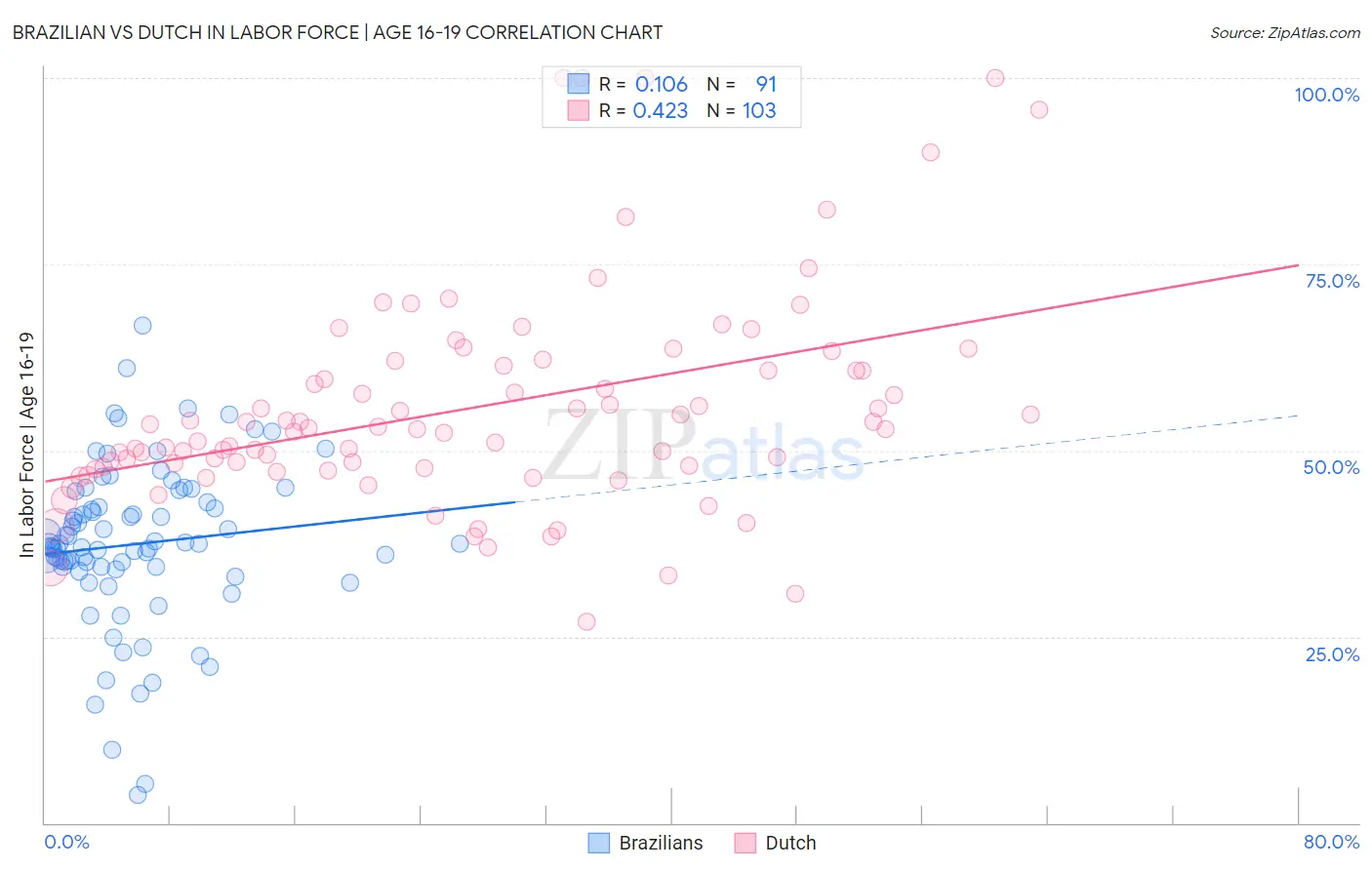Brazilian vs Dutch In Labor Force | Age 16-19
COMPARE
Brazilian
Dutch
In Labor Force | Age 16-19
In Labor Force | Age 16-19 Comparison
Brazilians
Dutch
37.5%
IN LABOR FORCE | AGE 16-19
88.7/ 100
METRIC RATING
147th/ 347
METRIC RANK
43.8%
IN LABOR FORCE | AGE 16-19
100.0/ 100
METRIC RATING
13th/ 347
METRIC RANK
Brazilian vs Dutch In Labor Force | Age 16-19 Correlation Chart
The statistical analysis conducted on geographies consisting of 323,588,239 people shows a poor positive correlation between the proportion of Brazilians and labor force participation rate among population between the ages 16 and 19 in the United States with a correlation coefficient (R) of 0.106 and weighted average of 37.5%. Similarly, the statistical analysis conducted on geographies consisting of 550,994,528 people shows a moderate positive correlation between the proportion of Dutch and labor force participation rate among population between the ages 16 and 19 in the United States with a correlation coefficient (R) of 0.423 and weighted average of 43.8%, a difference of 16.9%.

In Labor Force | Age 16-19 Correlation Summary
| Measurement | Brazilian | Dutch |
| Minimum | 3.7% | 27.0% |
| Maximum | 66.7% | 100.0% |
| Range | 63.0% | 73.0% |
| Mean | 37.4% | 55.7% |
| Median | 37.4% | 52.9% |
| Interquartile 25% (IQ1) | 34.3% | 47.7% |
| Interquartile 75% (IQ3) | 43.0% | 61.4% |
| Interquartile Range (IQR) | 8.7% | 13.7% |
| Standard Deviation (Sample) | 10.9% | 14.5% |
| Standard Deviation (Population) | 10.8% | 14.4% |
Similar Demographics by In Labor Force | Age 16-19
Demographics Similar to Brazilians by In Labor Force | Age 16-19
In terms of in labor force | age 16-19, the demographic groups most similar to Brazilians are Immigrants from Western Europe (37.5%, a difference of 0.030%), Japanese (37.5%, a difference of 0.080%), Paiute (37.5%, a difference of 0.080%), Pakistani (37.6%, a difference of 0.10%), and Sierra Leonean (37.6%, a difference of 0.13%).
| Demographics | Rating | Rank | In Labor Force | Age 16-19 |
| Estonians | 91.7 /100 | #140 | Exceptional 37.7% |
| Syrians | 90.7 /100 | #141 | Exceptional 37.6% |
| Sierra Leoneans | 89.7 /100 | #142 | Excellent 37.6% |
| Pakistanis | 89.5 /100 | #143 | Excellent 37.6% |
| Japanese | 89.3 /100 | #144 | Excellent 37.5% |
| Paiute | 89.3 /100 | #145 | Excellent 37.5% |
| Immigrants | Western Europe | 88.9 /100 | #146 | Excellent 37.5% |
| Brazilians | 88.7 /100 | #147 | Excellent 37.5% |
| Romanians | 87.3 /100 | #148 | Excellent 37.5% |
| Native Hawaiians | 85.0 /100 | #149 | Excellent 37.4% |
| Tsimshian | 84.7 /100 | #150 | Excellent 37.4% |
| Immigrants | Poland | 84.4 /100 | #151 | Excellent 37.3% |
| Immigrants | Sierra Leone | 83.6 /100 | #152 | Excellent 37.3% |
| Arapaho | 81.8 /100 | #153 | Excellent 37.3% |
| Immigrants | Bulgaria | 81.6 /100 | #154 | Excellent 37.3% |
Demographics Similar to Dutch by In Labor Force | Age 16-19
In terms of in labor force | age 16-19, the demographic groups most similar to Dutch are Chippewa (43.8%, a difference of 0.10%), Finnish (43.9%, a difference of 0.19%), Slovene (43.7%, a difference of 0.36%), Czech (43.6%, a difference of 0.47%), and Scandinavian (43.6%, a difference of 0.53%).
| Demographics | Rating | Rank | In Labor Force | Age 16-19 |
| Somalis | 100.0 /100 | #6 | Exceptional 45.1% |
| Danes | 100.0 /100 | #7 | Exceptional 44.7% |
| Immigrants | Cabo Verde | 100.0 /100 | #8 | Exceptional 44.7% |
| Cape Verdeans | 100.0 /100 | #9 | Exceptional 44.5% |
| Germans | 100.0 /100 | #10 | Exceptional 44.2% |
| Swedes | 100.0 /100 | #11 | Exceptional 44.1% |
| Finns | 100.0 /100 | #12 | Exceptional 43.9% |
| Dutch | 100.0 /100 | #13 | Exceptional 43.8% |
| Chippewa | 100.0 /100 | #14 | Exceptional 43.8% |
| Slovenes | 100.0 /100 | #15 | Exceptional 43.7% |
| Czechs | 100.0 /100 | #16 | Exceptional 43.6% |
| Scandinavians | 100.0 /100 | #17 | Exceptional 43.6% |
| French Canadians | 100.0 /100 | #18 | Exceptional 43.6% |
| Belgians | 100.0 /100 | #19 | Exceptional 43.4% |
| Swiss | 100.0 /100 | #20 | Exceptional 43.3% |